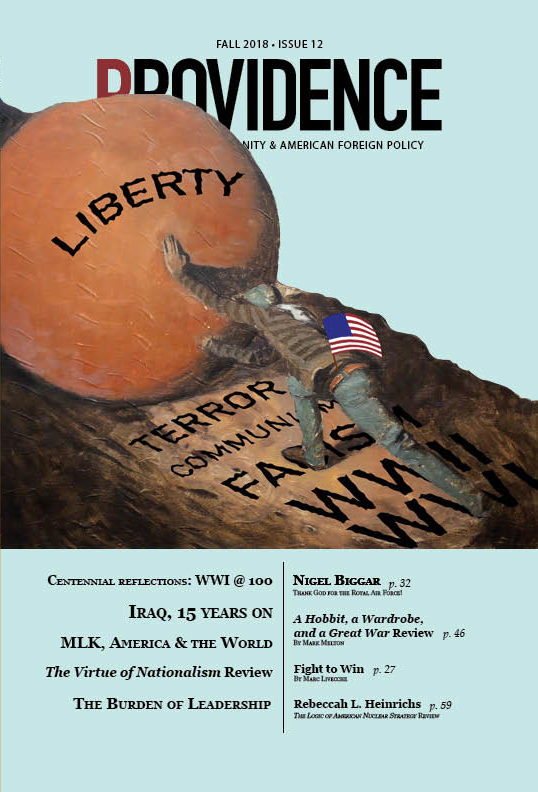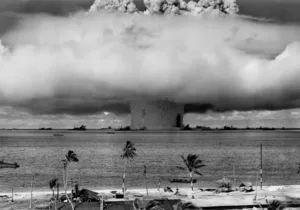There is a wide gap between how most nuclear weapons scholars regard the weapons and their influence on deterrence and how the United States government has historically devised its nuclear strategies. The scholars widely share a school of thought that assumes the United States’ maintaining a robust strategic posture and seeking nuclear superiority are at best unnecessary and costly and at worst destabilizing.
However, the United States has not historically devised its nuclear strategies and postures according to the scholars’ assumptions. Rather than seeking nuclear parity, recall that President John F. Kennedy famously wanted a nuclear arsenal that was “second to none.” At the height of the Cold War, both the Soviet Union and the United States amassed thousands of nuclear weapons. The US clearly found the idea of “parity” unpersuasive, as it raced to outmatch the USSR. Since the end of the Cold War, America and Russia have both maintained thousands of these weapons, far beyond what many scholars have insisted is necessary for deterrence purposes. According to them, if a nation assures it can retaliate with nuclear weapons after it has been the victim of an aggressor’s first nuclear strike, it does not need more than a handful of dispersed nuclear capabilities.
Dr. Matthew Kroenig’s book The Logic of American Nuclear Strategy provides an immensely important and forceful rebuttal to those nuclear scholars who have gained influence among average American citizens as well as within the walls of the Pentagon where nuclear strategy is conceived and carried out. In doing so, if I may note, the central theme in Logic also exposes the vacuity of the moral “arguments” mainline Christian “thought leaders” have pushed in the name of US disarmament advocacy.
Kroenig boldly grapples with this disconnect between theorists and practitioners, and he effectively argues the following thesis: in crisis situations where countries find themselves in irreconcilable conflicts, the country with the superior nuclear arsenal will possess greater resolve, and as a result it will win in a contest of wills, securing that superior nuclear power’s primary objective. He points to historical examples when nuclear powers did escalate nuclear threats in an attempt to secure a military objective, and in each example the country with numerical nuclear superiority won.
Most readers will find one example Kroenig provides quite familiar: the 1962 Cuban Missile Crisis. At the time, the United States possessed nuclear superiority with roughly 25,540 nuclear warheads, while the USSR possessed roughly 3,346. Additionally, the US had far more delivery systems in positions that could reach the Soviet homeland. The Soviets sought to correct this imbalance by placing medium and intermediate-range ballistic missiles in Cuba, which could reach anywhere in the United States. President Kennedy’s goal was to compel Premier Nikita Khrushchev to withdraw his missiles from Cuba, prompting the 13-day standoff. In the end, by escalating the crisis with an embargo, President Kennedy compelled the Soviets to withdraw the missiles, bringing the crisis to a favorable end for the United States. Kroenig ably provides ample evidence that the US nuclear superiority at the time was a driving consideration for both nations. He writes:
For example, during the Crisis, General Maxwell Taylor, who by then had replaced Lemnitzer as chairman of the Joint Chiefs of Staff, wrote in a memo to Secretary of Defense Robert McNamara, “we have the strategic advantage in our general war capabilities…this is no time to run scared.” Similarly, Secretary of State Dean Rusk said to the members of the EXCOMM [Executive Committee of the National Security Council], including President Kennedy, “One thing Mr. Khrushchev may have in mind is that…he knows that we have a substantial nuclear superiority…he also knows that we don’t really live under fear of his nuclear weapons to the extent…that he has to live under ours.” […] According to C. Douglas Dillon, a cabinet adviser to President Kennedy during the Crisis, the answer is straight forward: “Our nuclear preponderance was essential. That’s what made the Russians back off.”
Kroenig also effectively dismantles the persistent myth that “nobody wins a nuclear war.” Certainly, responsible nations should do everything within their power to deter the most catastrophic kinds of war, especially those that could involve weapons of mass destruction. Anticipating his critics’ complaints, Kroenig repeats this clarification throughout the book. (No reader should come away from the book believing Kroenig is arguing in favor of fighting nuclear wars. But no doubt, some will.) But it simply isn’t true that wars that involve such terrible weapons are unwinnable. As Kroenig bluntly writes, “While even a single nuclear weapon detonated in the United States would be a tragedy of historic proportions, it is also the case that twenty nuclear detonations would be far worse.” This borrows from the Cold War nuclear strategist Herman Khan, who powerfully argues that even when one thinks of the potential costs of a nuclear war, 10 million dead is awful, but one can distinguish it from 100 million dead and even prefer it.
Kroenig is right. Simply putting the idea of winning nuclear wars out of a nuclear strategist’s mind, when he or she is tasked with devising strategies for America’s nuclear force, is a dereliction of duty. Taking Kroenig’s logic (and Khan’s), one can draw another important conclusion: preparing to fight and win a nuclear war—especially with nations that show a propensity to lower the nuclear threshold for when they might consider a first strike (think Russia)—bolsters the US nuclear deterrent’s credibility and therefore its effectiveness in deterring war in the first place. The more effective the US deterrent is, the less likely the US ever has to employ nuclear weapons at all.
These issues are often not intuitive to most Americans—even those who are well-informed and morally concerned. Busy American Christians often look to the heads of their churches for a quick take on the issues of the day. Public opinion can shift when leaders in the mainline churches, including the Catholic Church, adopt the views of many prominent nuclear weapons scholars who favor disarmament to the lowest possible number of nuclear weapons “necessary for deterrence.” Well-intentioned Americans can unfortunately misunderstand that their views actually increase the chances of a failure in deterrence, and those views can be manifested in polices of elected government officials.
To illustrate this danger, President Obama’s view, although in line with many scholars, offered a significant departure from the assumptions that had underpinned US nuclear strategies, regardless of the governing political party.
In 2009 President Obama called for a renewed commitment to seek a world without nuclear weapons and then began a plan to do just that. For example, he committed to pursuing the ratification of a global ban on nuclear testing. (President George H.W. Bush placed a unilateral ban on US nuclear testing, and every subsequent president has maintained it.) He negotiated the New START Treaty with the Russians, which capped the number of both nations’ deployed strategic nuclear weapons. This agreement had the effect of cutting US numbers while Russia was already below the threshold; Russia has, in fact, built up its deployed strategic weapons. The Obama nuclear policy document, the Nuclear Posture Review, explicitly stated the intent to reduce the role of nuclear weapons in our national security strategy. And, even when faced with evolving nuclear threat challenges, the administration chose not to pvolvingdditional nuclear capabilities.
To the Obama administration’s credit, it backed off on furthering its disarmament agenda after Russia invaded Ukraine and annexed Crimea. Furthermore, Republicans in the Senate refused to ratify the New START Treaty until the president assured them that he would cooperate on nuclear modernization of the remaining force, which he did. Even President Obama, so ideologically committed to leading the world down the path to zero nuclear weapons, was persuaded that the existing threats required the United States to maintain a nuclear force of thousands of nuclear weapons, and that it had to seriously consider upgraded capabilities in the event it really had to use them in a nuclear conflict with peer competitors.
The Trump administration’s approach to nuclear deterrence is much more in line with the thesis of Kroenig’s book, which is good news for Americans. Although, there is much work to be done to bolster the US nuclear posture to provide an overwhelmingly obvious nuclear advantage against the Russians, as they seem to believe they have an advantage via tactical nuclear weapons.
Upon reading Logic, one note of caution is that no nuclear strategist should take too much comfort in America’s previous and seemingly current nuclear superiority. Many factors are built into any national leader’s calculus about his or her country’s interests and what it is willing to risk in their pursuit, including the degree to which it participates in nuclear brinksmanship. A far inferior nuclear power like North Korea, for example, could quite possibly be willing to escalate a conflict in the pursuit of objectives it deems important, counting on the more humane and responsible American public to resist responding. Then the North may foolishly provoke a nuclear exchange with the United States that results in millions of lives lost. But, underscoring the central theme of Logic, even if deterrence breaks down in this horribly regrettable scenario, North Korea stands zero chance of winning a nuclear exchange with the United States.
Anyone who desires the United States to succeed in its international pursuits and reads Kroenig’s book should conclude that the US must maintain a robust nuclear arsenal that is superior to those of all other nations. The downsides of doing so simply pale in comparison to the great upsides, the greatest one being the very survival of the United States of America.
Rebeccah L. Heinrichs, a contributing editor at Providence, is a fellow at Hudson Institute, where she provides research and commentary on a variety of international security issues and specializes in deterrence and counter-proliferation. She is also the vice-chairman of the John Hay Initiative’s Counter-Proliferation Working Group and the original manager of the House of Representatives Bipartisan Missile Defense Caucus.








 Sponsor a student for Christianity & National Security 2024
Sponsor a student for Christianity & National Security 2024